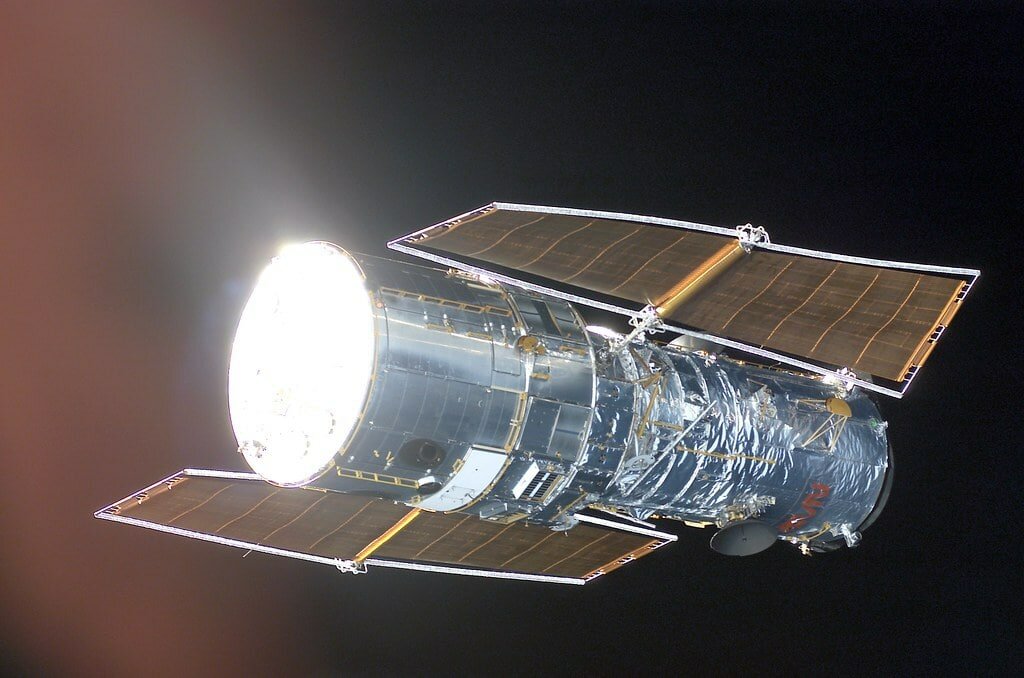What type of telescope is the hubble space telescope? The Hubble Space Telescope (also known as Hubble or HST) is a space telescope that was deployed into low-Earth orbit in 1990. This telescope is still operational today. This isn't the first space telescope, however, it is one of the biggest and most versatile, regarded as a crucial research instrument as well as a public relations boost for astronomy. The Hubble telescope is one of NASA's Great Observatories and is dedicated after astronomer Edwin Hubble.
Hubble has a 7 feet 10 inches mirror, and its 5 main instruments look at the electromagnetic spectrum in the ultraviolet, near-infrared and visible wavelengths. Hubble's orbit outside of the Earth's distorted atmosphere allows it to collect extraordinarily high-resolution photos with significantly less background light compared to ground-based observatories. It has captured several of the most accurate visible light photos to date, providing a window into the depths of space. Several Hubble findings led to astrophysics breakthroughs, such as estimating the universe's expansion rate.

When was the Hubble space telescope launched?
The Hubble telescope was sponsored and developed by the US space agency NASA with support from the European Space Agency in the 1970s. It was supposed to launch in 1983, however the project was hampered by technical issues, finance issues, and the Challenger catastrophe in 1986. Hubble was deployed in 1990, but its primary mirror had been ground improperly, causing spherical aberration that limited the telescope's capabilities. A servicing trip in 1993 restored the optics to their original condition.
Hubble seems to be the only telescope built to be maintained by humans in space. All five of the telescope's principal instruments have been repaired, updated, or replaced thanks to five Space Shuttle trips. The fifth mission was initially cancelled for safety reasons after the Columbia tragedy in 2003. After NASA administrator called Michael D. Griffin authorized it in 2009, it was accomplished. The telescope celebrated its 30th anniversary in April 2020, and it is expected to continue operating until 2030 to 2040.
Images in Colour
Hubble's photos are monochromatic grayscale, captured using a range of filters that pass different wavelengths of light and are built into each camera. Colour images are made by mixing monochrome photographs that have been filtered differently. This method can also produce false-colour images with ultraviolet and infrared channels, wherein infrared is normally represented as a deep red and UV is usually displayed as a deep blue.
Hubble Space Telescope's Future
Hubble orbits our Earth in the ultra-thin upper atmosphere, and its orbit decays with time due to drag. If it is not accelerated, it will re-enter the Earth's atmosphere after a few decades, the exact date depends on how busy the Sun is and its effect on the upper atmosphere. Parts of the primary mirror as well as its support system would likely survive a completely unrestricted re-entry, leaving the possibility of damage or possibly human casualties.
Hubble, according to assistant project manager James Jeletic, could last until the 2020s.
Hubble's natural atmospheric re-entry will take place between 2028 - 2040, depending on the activity of the solar and atmospheric drag (or lack thereof). Hubble's service contract was renewed by NASA through June 2021 in June 2016.
The Hubble’s successor
Because near-term space telescopes don't really duplicate Hubble's wavelength span (near-infrared and near-ultraviolet wavelengths), instead focusing on very far infrared bands, there is no direct equivalent for Hubble as a visible and an ultraviolet light space telescope.
These bands are best for investigating objects with a low temperature and high redshift, which are ancient and far away in the cosmos. The expenditure of space-based telescopes is justified because certain wavelengths are difficult or even impossible to examine from the ground.
What type of telescope is the hubble space telescope
A huge ground-based telescope can image the same kind of wavelengths as Hubble, and sometimes can challenge HST as far as resolution by utilizing adaptive optics (AO), have more power to gather light, and can be updated with ease. Nevertheless, they still can't beat Hubble's amazing resolution across a wide field of view even against the dark space's background.
Figures and facts
- Hubble has a maximum diameter of about 14 feet and a width of 43.5 feet. It'd weigh 24,500 pounds on Earth i.e 11,110 kilograms.
- The Hubble space telescope was launched on the space shuttle Discovery on April 24, 1990, and was installed a day later.
- Hubble circles Earth at a height of about 340 miles o r547 kilometres, on a route inclined approximately 28.5 degrees towards the equator. It travels at an average speed of 17,000 mph or 27,000 kph, and one orbit takes 95 minutes.
- Every week, Hubble sends out around 120 terabytes of science data. That's about 3,600 feet (1,097 meters) of books placed on a shelf. Magneto-optical disks hold the collection of these images and data.
- The primary mirror of the telescope is 94.5 inches (2.4 meters) diameter and weight is 1,825 pounds or 828 kg. Its second mirror is 12 inches (0.3 meters) in width and weighs 27.4 pounds or12.3 kg.
- Hubble has been serviced five times by astronauts, on missions deployed in Dec 1993, Feb 1997, Dec 1999, Feb 2002, and May 2009.